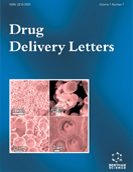Abstract
Background: 7–hydroxy–14H–naphtho[2,3–a]phenothiazine–8,13–dione (AQATP) was synthesized by using iodobenzenediacetate as catalyst from 1,4–dihydroxyanthraquinone (1,4–AQ) which was isolated from Cassia tora seeds. Methods: They were then characterized by various spectral techniques. Single crystal X-ray diffraction studies revealed that AQATP crystallizes in orthorhombic space group. ADME Test was performed to determine pharmacokinetic parameter using MedChem designer software. The In silico docking studies were performed to find out the anticancer effect of 1,4–AQ and AQATP using iGEMDOCK software taking CK2 protein as the target. In silico anti-inflammatory study was also carried out by means of the same software taking COX–2 and LOX–5 enzymes as the targets. Results: It was found that the derivative exhibited more binding affinity than the parent compound for both anticancer and anti-inflammatory activities. In vitro anticancer activity in colon cancer cell lines, anti-inflammatory activity by denaturation, COX and LOX assay were performed on AQATP. Conclusion: Results from both computational and in vitro analysis suggest that structural modification of 1,4–AQ could be considered as a good strategy to obtain a lead molecule for drug discovery.
Keywords: Anticancer, anti-inflammatory, AQATP, cassia tora, docking studies, 1, 4–dihydroxyanthraquinone.
Drug Delivery Letters
Title:Synthesis, Single Crystal Study, in silico Analysis, in vitro Antiinflammatory and Anticancer Activities of 7-hydroxy-14H-naphtho[2,3- a]phenothiazine-8,13-dione
Volume: 5 Issue: 2
Author(s): Shiny P. Laila, Annette Fernandez, Arun Kumar, Viswanadhan S. Vishnu, Rema D. Krishnan, Archana P. Das and Ompallil Thomas
Affiliation:
Keywords: Anticancer, anti-inflammatory, AQATP, cassia tora, docking studies, 1, 4–dihydroxyanthraquinone.
Abstract: Background: 7–hydroxy–14H–naphtho[2,3–a]phenothiazine–8,13–dione (AQATP) was synthesized by using iodobenzenediacetate as catalyst from 1,4–dihydroxyanthraquinone (1,4–AQ) which was isolated from Cassia tora seeds. Methods: They were then characterized by various spectral techniques. Single crystal X-ray diffraction studies revealed that AQATP crystallizes in orthorhombic space group. ADME Test was performed to determine pharmacokinetic parameter using MedChem designer software. The In silico docking studies were performed to find out the anticancer effect of 1,4–AQ and AQATP using iGEMDOCK software taking CK2 protein as the target. In silico anti-inflammatory study was also carried out by means of the same software taking COX–2 and LOX–5 enzymes as the targets. Results: It was found that the derivative exhibited more binding affinity than the parent compound for both anticancer and anti-inflammatory activities. In vitro anticancer activity in colon cancer cell lines, anti-inflammatory activity by denaturation, COX and LOX assay were performed on AQATP. Conclusion: Results from both computational and in vitro analysis suggest that structural modification of 1,4–AQ could be considered as a good strategy to obtain a lead molecule for drug discovery.
Export Options
About this article
Cite this article as:
Laila P. Shiny, Fernandez Annette, Kumar Arun, Vishnu S. Viswanadhan, Krishnan D. Rema, Das P. Archana and Thomas Ompallil, Synthesis, Single Crystal Study, in silico Analysis, in vitro Antiinflammatory and Anticancer Activities of 7-hydroxy-14H-naphtho[2,3- a]phenothiazine-8,13-dione, Drug Delivery Letters 2015; 5 (2) . https://dx.doi.org/10.2174/221030310502151214165344
| DOI https://dx.doi.org/10.2174/221030310502151214165344 |
Print ISSN 2210-3031 |
| Publisher Name Bentham Science Publisher |
Online ISSN 2210-304X |
 28
28
- Author Guidelines
- Bentham Author Support Services (BASS)
- Graphical Abstracts
- Fabricating and Stating False Information
- Research Misconduct
- Post Publication Discussions and Corrections
- Publishing Ethics and Rectitude
- Increase Visibility of Your Article
- Archiving Policies
- Peer Review Workflow
- Order Your Article Before Print
- Promote Your Article
- Manuscript Transfer Facility
- Editorial Policies
- Allegations from Whistleblowers
Related Articles
-
Challenges in Managing Amniotic Fluid Embolism: An Up-to-Date Perspective on Diagnostic Testing with Focus on Novel Biomarkers and Avenues for Future Research
Current Pharmaceutical Biotechnology Stroke Risk Stratification Schemes in Atrial Fibrillation in the Era of Non- Vitamin K Anticoagulants: Misleading and Obsolete, At Least for the “Low-Risk” Patients?
Current Drug Targets Phytol a Natural Diterpenoid with Pharmacological Applications on Central Nervous System: A Review
Recent Patents on Biotechnology Myocardial Infarction. Pathological Relevance and Relationship with Coronary Risk Factors
Current Pharmaceutical Design Polyphenols Regulate Endothelial Functions and Reduce the Risk of Cardiovascular Disease
Current Pharmaceutical Design A Palliative Care Approach to the Advanced Heart Failure Patient
Current Cardiology Reviews Polyphenols: A Diverse Class of Multi-Target Anti-HIV-1 Agents
Current Drug Metabolism Polypharmacology in Drug Discovery: A Review from Systems Pharmacology Perspective
Current Pharmaceutical Design Plastid Molecular Pharming II. Production of Biopharmaceuticals by Plastid Transformation
Mini-Reviews in Medicinal Chemistry Omega-3 Polyunsaturated Fatty Acids: Their Potential Role in Blood Pressure Prevention and Management
Current Vascular Pharmacology Insulin Resistance, Small LDL Particles, and Risk for Atherosclerotic Disease
Current Vascular Pharmacology Patenting of Nanopharmaceuticals in Drug Delivery: No Small Issue
Recent Patents on Drug Delivery & Formulation Pathophysiological and Clinical Aspects of Iron Chelation Therapy in MDS
Current Pharmaceutical Design Subject Index To Volume 6
Current Molecular Medicine A Review on Genus Alseodaphne: Phytochemistry and Pharmacology
Mini-Reviews in Organic Chemistry Impact of Chronic Kidney Disease on Risk for Vascular Events
Current Vascular Pharmacology Heat Shock Protein-60 and Risk for Cardiovascular Disease
Current Pharmaceutical Design Three Dimensional Echocardiography: Recent Trends in Segmen tation Methods
Current Medical Imaging The TOLL-like / Type-I Interferon Pathways as Emerging Therapeutic Targets for Autoimmune Diseases
Drug Design Reviews - Online (Discontinued) Determinants of the Resolution of Type 2 Diabetes After Bariatric Surgery
Vascular Disease Prevention (Discontinued)


























